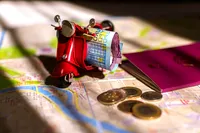Currency in Lithuania
What Currency Does Lithuania Use Now

Wondering what currency you'll need on your trip to Lithuania? Well, let's answer that for you! Since the 1st of January 2015, the official currency of Lithuania is the Euro (€). The Baltic nation got permission to join the Eurozone after meeting all Maastricht criteria, which includes having a stable currency, budget deficit below 3% of GDP, national debt under 60% of GDP, and more.
The shift from the Lithuanian litas (LTL) to the Euro was an effort to solidify economic security, boost Lithuania's trade markets, and offer greater security as a part of the overall Eurozone. This has made it even more convenient for tourists across Europe and the world as they enjoy the homogeneity of currency.
Credit and Debit Cards in Lithuania

When it comes to card transactions, Lithuania is on par with some of the most developed nations in the world. Credit and debit cards, particularly those issued by Visa and MasterCard, are widely accepted in major Lithuanian cities such as Vilnius and Kaunas. You'll find most restaurants, hotels, shops, and even some taxis accepting card payments.
Chip-and-PIN cards are the norm, as Lithuania has entirely moved away from the magnetic strip system, making transactions more secure. If you're from a country still using magnetic strip cards, it may be a good idea to let your bank know about your travel plans to avoid any potential inconvenience.
Using Cash in Lithuania
Although card payments are widely accepted in Lithuania, it's always handy to have some cash for emergencies and scenarios where digital payments may not be possible. Euro banknotes and coins are used throughout the country. Small establishments in remote areas might prefer cash over card transactions. Additionally, some small shops and cafés might also impose minimum spending limits for card payments.
It's always prudent to carry a mix of cash and cards to avoid any monetary concerns on your trip. You can exchange your currency to Euros at local banks or authorized foreign exchange bureaus in the city to avail of competitive rates.
ATMs in Lithuania

Finding an ATM in Lithuania is fairly easy, especially in cities and larger towns. International debit or credit cards can be used to withdraw cash from most ATMs, keeping in mind that there may be fees related to these transactions. Your bank or the ATM operator could apply such charges.
It's worth noting that most ATMs in Lithuania offer an English language option, making the banking process convenient for travelers. Also, the ATMs dispense funds in Euros, which should be noted by those accustomed to multi-currency ATMs in other European countries.
Bank Hours
Like many European nations, Lithuanian banks typically operate from Monday to Friday, with business hours between 9:00 AM and 5:00 PM. Some banks may have slightly extended hours, staying open later on Fridays. Lithuanian banks are typically closed on weekends and public holidays, which is consistent with European banking norms. Certain bank branches in larger cities and shopping malls may offer extended hours for the benefit of customers.
In conclusion, whether it's cash, credit, or debit cards, or using ATMs, monetary transactions are made simple in Lithuania, with customer convenience being a top priority. Explore this Baltic beauty with the assurance that your financial needs will be taken care of effortlessly.
